
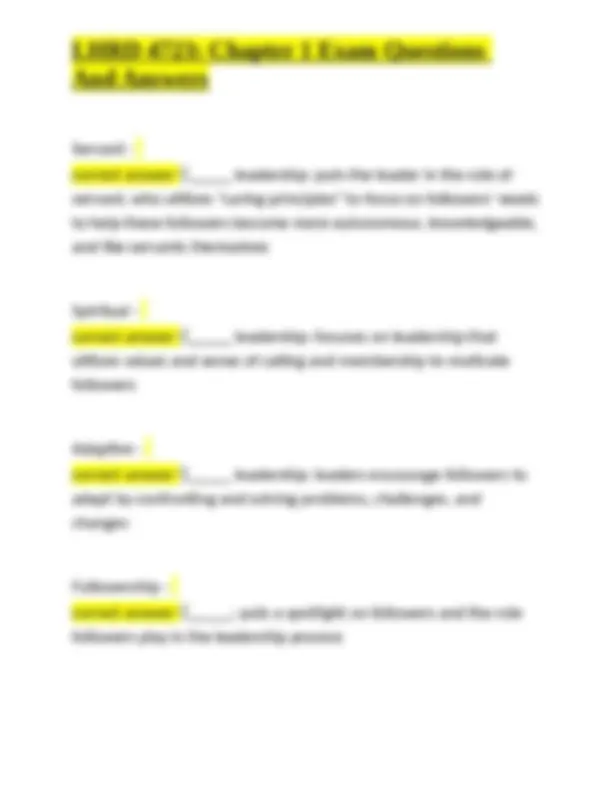
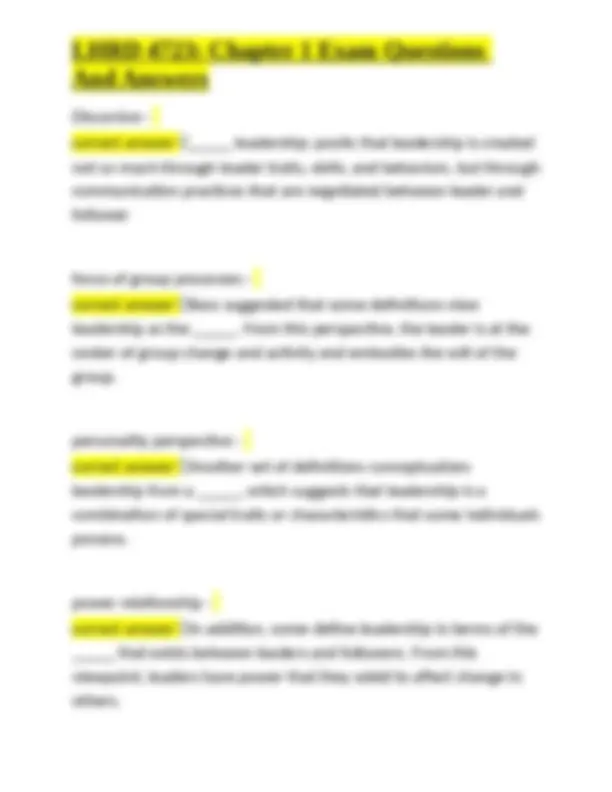
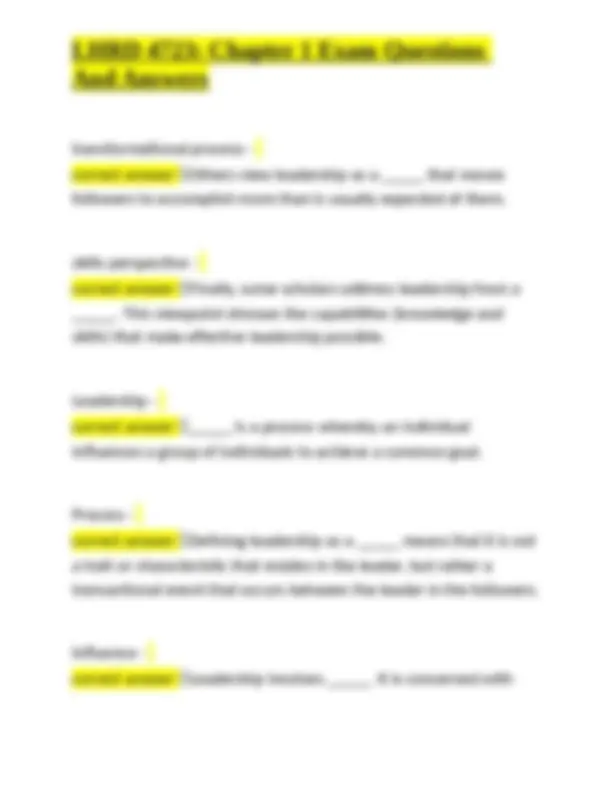
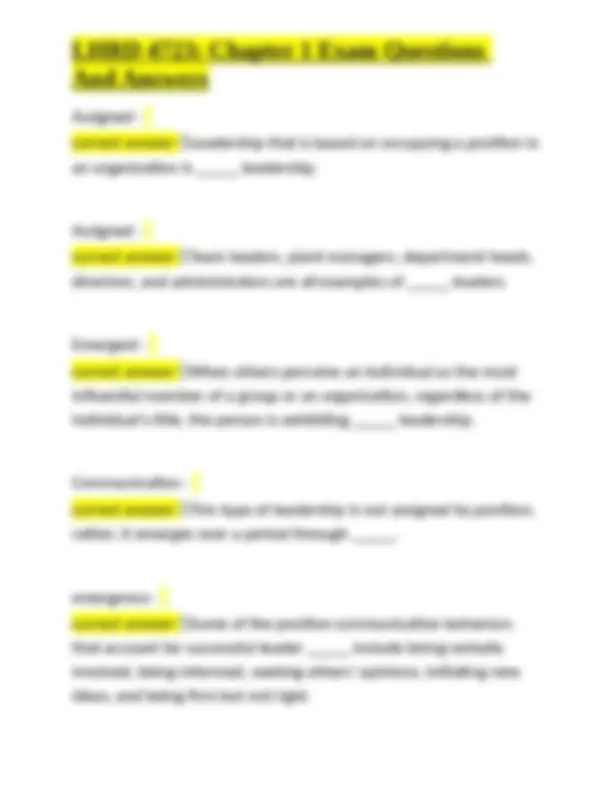
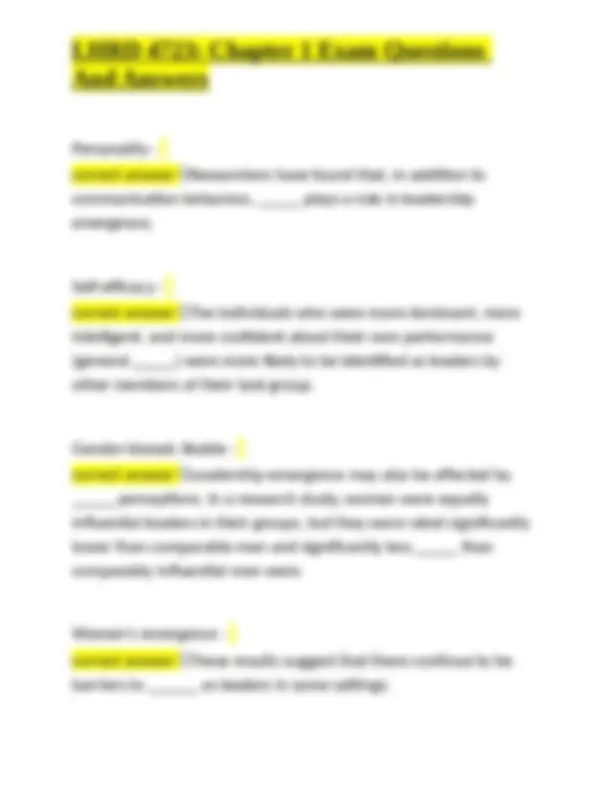
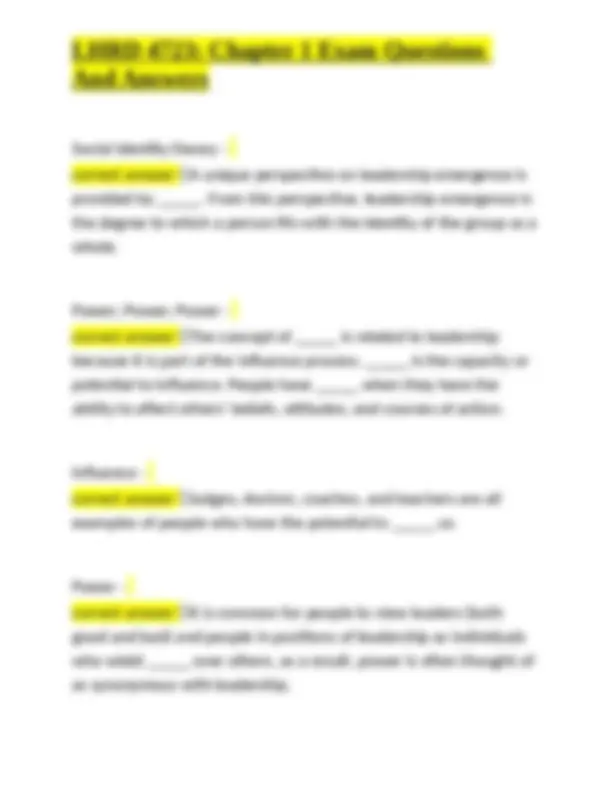
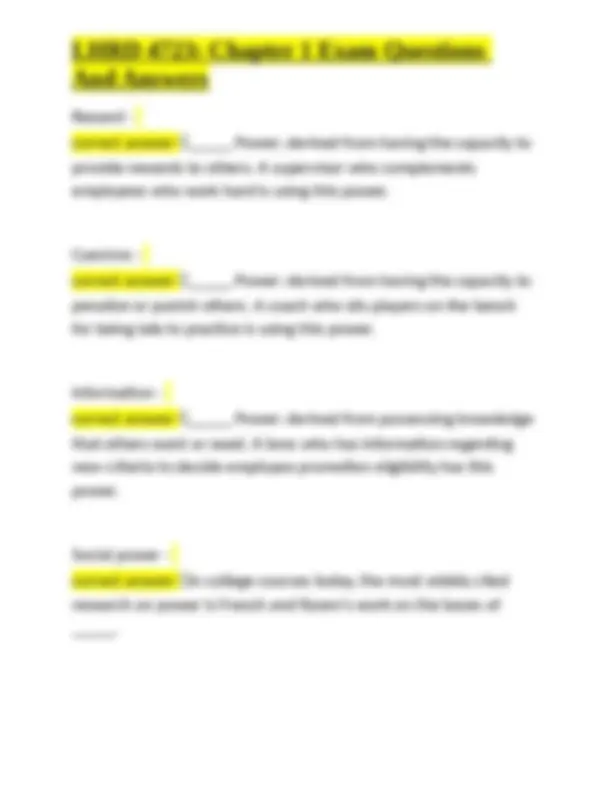
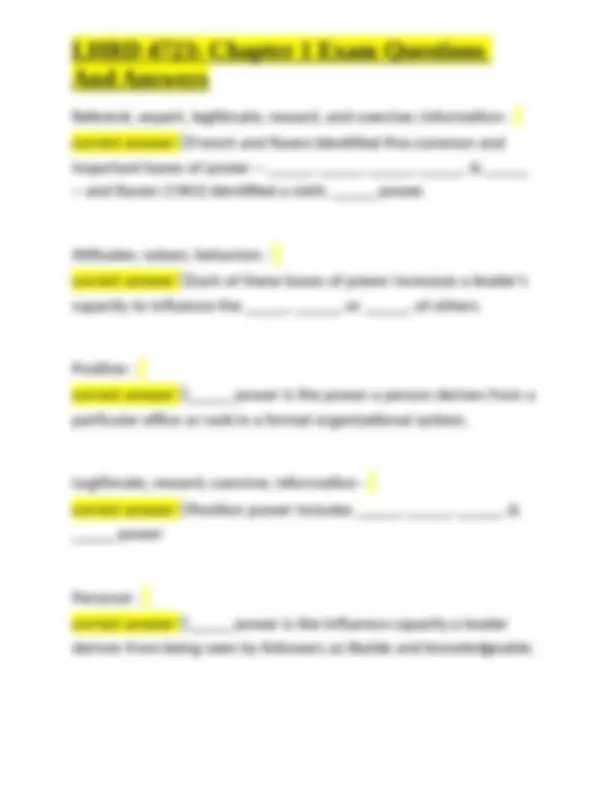
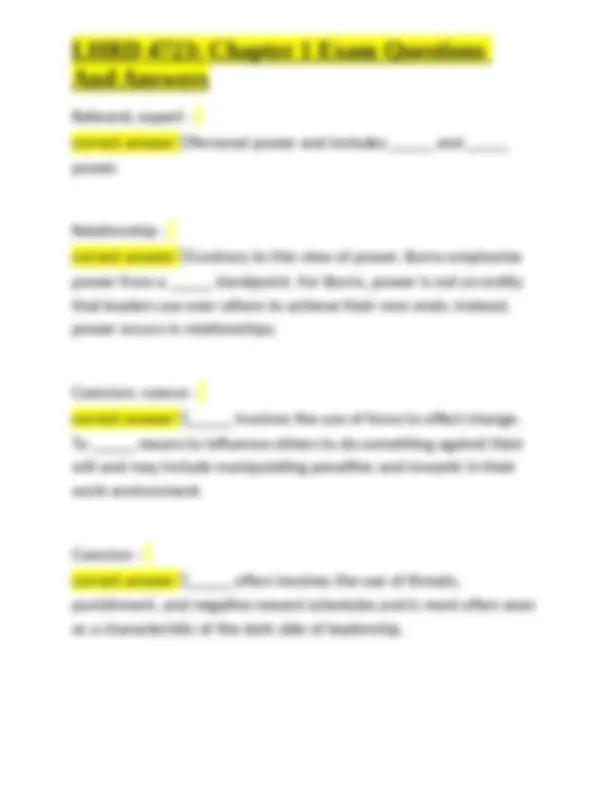
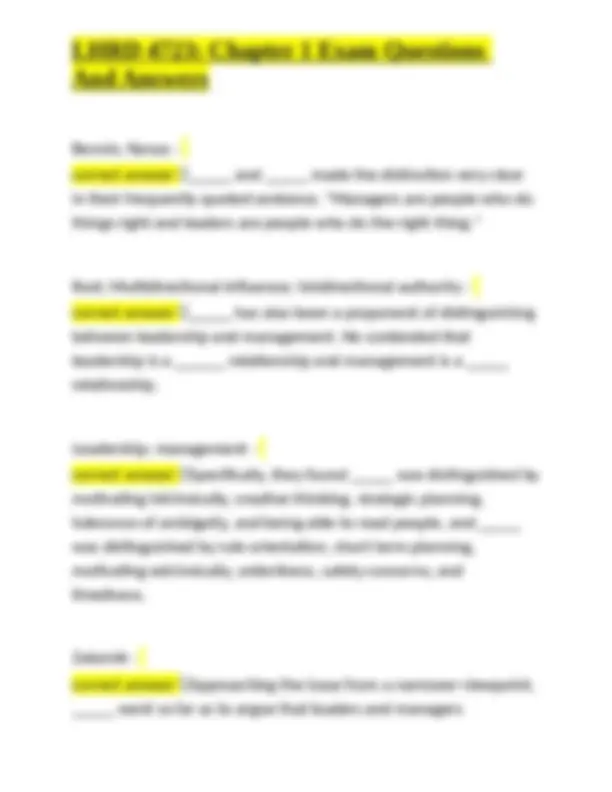
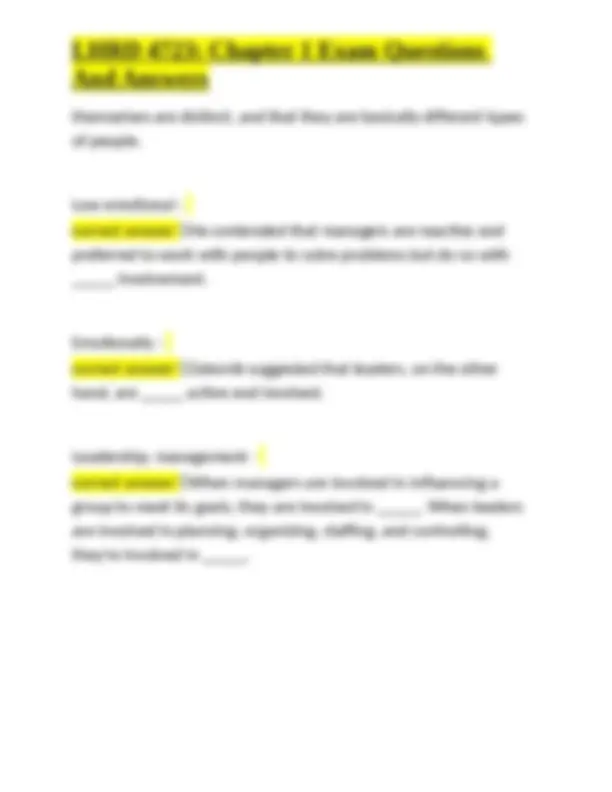


Study with the several resources on Docsity

Earn points by helping other students or get them with a premium plan


Prepare for your exams
Study with the several resources on Docsity

Earn points to download
Earn points by helping other students or get them with a premium plan
Community
Ask the community for help and clear up your study doubts
Discover the best universities in your country according to Docsity users
Free resources
Download our free guides on studying techniques, anxiety management strategies, and thesis advice from Docsity tutors
LHRD 4723: Chapter 1 Exam Questions And Answers
Typology: Exams
1 / 19

This page cannot be seen from the preview
Don't miss anything!












domination - correct answer ✅The first three decades of the 20th Century emphasize control and centralization of power with a common theme of _____. traits - correct answer ✅In the 1930s, _____ became the focus of defining leadership, with an emerging view of leadership as influence rather than domination. group - correct answer ✅The _____ approach came into the forefront in the 1940s with leadership being defined as the behavior of an individual while involved in directing group activities. group; relationship; effectiveness - correct answer ✅Three themes dominated leadership definitions during the 1950s:
Discursive - correct answer ✅_____ leadership: posits that leadership is created not so much through leader traits, skills, and behaviors, but through communication practices that are negotiated between leader and follower focus of group processes - correct answer ✅Bass suggested that some definitions view leadership as the _____. From this perspective, the leader is at the center of group change and activity and embodies the will of the group. personality perspective - correct answer ✅Another set of definitions conceptualizes leadership from a _____, which suggests that leadership is a combination of special traits or characteristics that some individuals possess. power relationship - correct answer ✅In addition, some define leadership in terms of the _____ that exists between leaders and followers. From this viewpoint, leaders have power that they wield to affect change in others.
transformational process - correct answer ✅Others view leadership as a _____ that moves followers to accomplish more than is usually expected of them. skills perspective - correct answer ✅Finally, some scholars address leadership from a _____. This viewpoint stresses the capabilities (knowledge and skills) that make effective leadership possible. Leadership - correct answer ✅_____ is a process whereby an individual influences a group of individuals to achieve a common goal. Process - correct answer ✅Defining leadership as a _____ means that it is not a trait or characteristic that resides in the leader, but rather a transactional event that occurs between the leader in the followers. Influence - correct answer ✅Leadership involves _____. It is concerned with
leader - correct answer ✅Although leaders and followers are closely linked, it is the _____ who often initiates the relationship, creates the communication linkages, and carries the burden for maintaining the relationship. trait - correct answer ✅The _____ perspective suggests that certain individuals have special innate or inborn characteristics or qualities that make them leaders, and that it is these qualities that differentiate them from non-leaders. Process - correct answer ✅The _____ viewpoint suggests that leadership is a phenomenon that resides in the context of the interactions between leaders and followers and makes leadership available to everyone. Process - correct answer ✅The _____ definition of leadership is consistent with the definition of leadership that we have set forth in this chapter.
Assigned - correct answer ✅Leadership that is based on occupying a position in an organization is _____ leadership. Assigned - correct answer ✅Team leaders, plant managers, department heads, directors, and administrators are all examples of _____ leaders. Emergent - correct answer ✅When others perceive an individual as the most influential member of a group or an organization, regardless of the individual's title, the person is exhibiting _____ leadership. Communication - correct answer ✅This type of leadership is not assigned by position; rather, it emerges over a period through _____. emergence - correct answer ✅Some of the positive communication behaviors that account for successful leader _____ include being verbally involved, being informed, seeking others' opinions, initiating new ideas, and being firm but not rigid.
Social identity theory - correct answer ✅A unique perspective on leadership emergence is provided by _____. From this perspective, leadership emergence is the degree to which a person fits with the identity of the group as a whole. Power; Power; Power - correct answer ✅The concept of _____ is related to leadership because it is part of the influence process. _____ is the capacity or potential to influence. People have _____ when they have the ability to affect others' beliefs, attitudes, and courses of action. Influence - correct answer ✅Judges, doctors, coaches, and teachers are all examples of people who have the potential to _____ us. Power - correct answer ✅It is common for people to view leaders (both good and bad) and people in positions of leadership as individuals who wield _____ over others, as a result, power is often thought of as synonymous with leadership.
Personal ends - correct answer ✅Understanding how power is used in leadership is instrumental as well in understanding the dark side of leadership, where leaders use their leadership to achieve their own _____ and lead in toxic and destructive ways. Followers - correct answer ✅Power used to be the domain of leaders, but that is diminishing and shifting to _____. Culture - correct answer ✅Changes in _____ have meant followers demand more from leaders, and leaders have responded. Transparent; decline - correct answer ✅Access to technology has empowered followers, given them access to huge amounts of information, and made leaders more _____. The result is a _____ in respect for leaders and leaders' legitimate power.
Reward - correct answer ✅_____ Power: derived from having the capacity to provide rewards to others. A supervisor who complements employees who work hard is using this power. Coercive - correct answer ✅_____ Power: derived from having the capacity to penalize or punish others. A coach who sits players on the bench for being late to practice is using this power. Information - correct answer ✅_____ Power: derived from possessing knowledge that others want or need. A boss who has information regarding new criteria to decide employee promotion eligibility has this power. Social power - correct answer ✅In college courses today, the most widely cited research on power is French and Raven's work on the bases of _____.
Referent, expert, legitimate, reward, and coercive; information - correct answer ✅French and Raven identified five common and important bases of power -- _____, _____, _____, _____, & _____ -- and Raven (1965) identified a sixth, _____ power. Attitudes; values; behaviors - correct answer ✅Each of these bases of power increases a leader's capacity to influence the _____, _____, or _____, of others. Position - correct answer ✅_____ power is the power a person derives from a particular office or rank in a formal organizational system. Legitimate; reward; coercive; information - correct answer ✅Position power includes _____, _____, _____, & _____ power Personal - correct answer ✅_____ power is the influence capacity a leader derives from being seen by followers as likable and knowledgeable.
Coercion; leadership - correct answer ✅It is important to distinguish between _____ and _____ because it allows us to separate out from our examples of leadership the behaviors of individuals such as Hitler, the Taliban, and Jones. own goals - correct answer ✅Leaders who use coercion are interested in their _____ and seldom are interested in the wants and needs of followers. with - correct answer ✅Using coercion runs counter to working _____ followers to achieve a common goal. industrialized; management - correct answer ✅Whereas the study of leadership can be traced back to Aristotle, management emerged around the turn of the 20th Century with the advent of our _____ society. _____ was created as a way to reduce chaos in organizations, to make them run more effectively and efficiently.
Planning; organizing; staffing; controlling - correct answer ✅The primary functions of management as first identified by Fayol, were _____, _____, _____, and _____. Management; leadership - correct answer ✅The overriding function of _____ is to provide order and consistency to organizations, whereas the primary function of _____ is to produce change and movement. Management; leadership - correct answer ✅To be effective, organizations need to nourish both competent _____ and skilled _____. Bennis; Nanus - correct answer ✅Many scholars argue that leadership and management are distinct constructs. For example, _____ and _____ maintained that there is a significant difference between the two. manage; lead - correct answer ✅To _____ means to accomplish activities in master routines, whereas to _____ means to influence others and create visions for change.
themselves are distinct, and that they are basically different types of people. Low emotional - correct answer ✅He contended that managers are reactive and preferred to work with people to solve problems but do so with _____ involvement. Emotionally - correct answer ✅Zaleznik suggested that leaders, on the other hand, are _____ active and involved. Leadership; management - correct answer ✅When managers are involved in influencing a group to meet its goals, they are involved in _____. When leaders are involved in planning, organizing, staffing, and controlling, they're involved in _____.